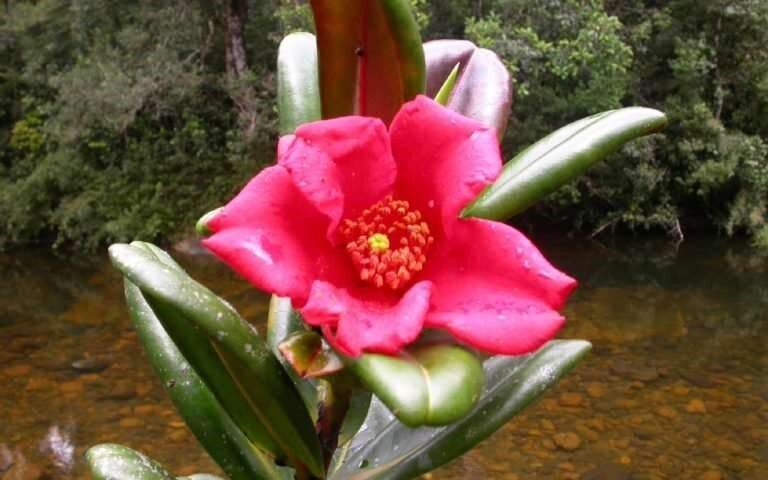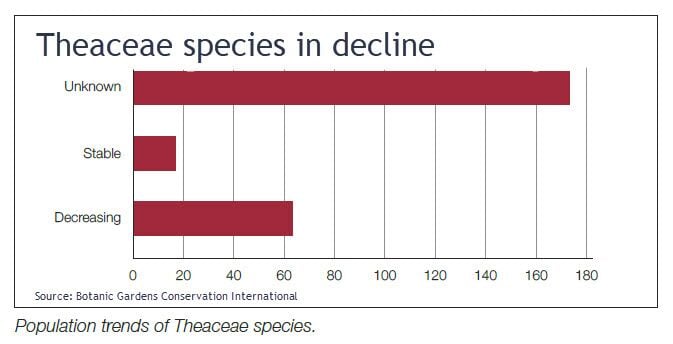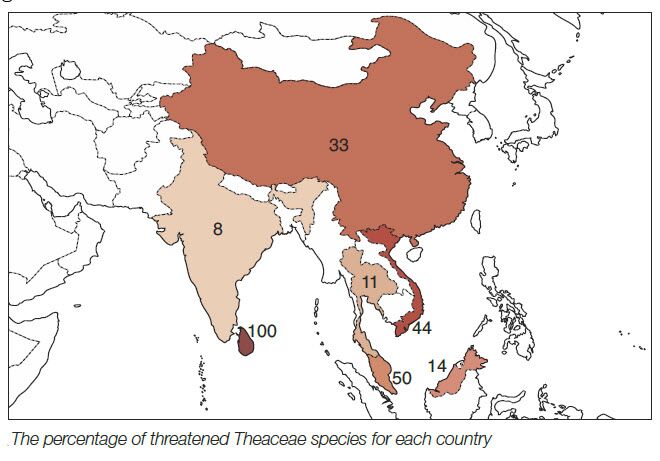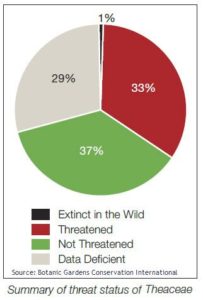 Wild tea is as vulnerable to the vagaries of man and nature as any flowering tree. It may appear prolific, with hundreds of millions of cultivated plants producing billions of kilos annually, but researchers report two of the world’s tea species could soon be extinct.
Plants go extinct with some frequency but a “Red List” of endangered Theaceae compiled by the Global Trees Campaign, reveals up to 45 percent of the camellia species are at risk of extinction in the wild.
Wild tea is as vulnerable to the vagaries of man and nature as any flowering tree. It may appear prolific, with hundreds of millions of cultivated plants producing billions of kilos annually, but researchers report two of the world’s tea species could soon be extinct.
Plants go extinct with some frequency but a “Red List” of endangered Theaceae compiled by the Global Trees Campaign, reveals up to 45 percent of the camellia species are at risk of extinction in the wild.
 Trees are considered critically threatened when fewer than 50 individuals are found in the wild. There are an estimated 10,000 tree species known to be threatened.
The research, as reported by Phys.org, was financed as a joint initiative by Fauna & Flora International and Botanic Gardens Conservation International (BGCI). Fauna & Flora is the world’s oldest international conservation organization.
Megan Barstow, a BGCI conservation assistant and one of the authors of the red list, writes that “sadly, two species of tea, Franklinia alatamaha and Camellia amplexicaulis, are already extinct in the wild, highlighting the urgent need for conservation action.”
Trees are considered critically threatened when fewer than 50 individuals are found in the wild. There are an estimated 10,000 tree species known to be threatened.
The research, as reported by Phys.org, was financed as a joint initiative by Fauna & Flora International and Botanic Gardens Conservation International (BGCI). Fauna & Flora is the world’s oldest international conservation organization.
Megan Barstow, a BGCI conservation assistant and one of the authors of the red list, writes that “sadly, two species of tea, Franklinia alatamaha and Camellia amplexicaulis, are already extinct in the wild, highlighting the urgent need for conservation action.”
 Researchers identified a dozen major threats with agriculture, urban development, and deforestation the top three. Climate change is identified as a threat to five species.
Camellia sinensis, the source of tea leaves on which the industry relies, was assessed as “data deficient, due to a lack of available information on the species wild population, despite its global cultivation,” writes Barstow.
Researchers identified 254 Theaceae species in their 2017 assessment, of which 32 are critically endangered. Among this group 85 (equivalent to 33 percent) are judged to be threatened with extinction.
Researchers identified a dozen major threats with agriculture, urban development, and deforestation the top three. Climate change is identified as a threat to five species.
Camellia sinensis, the source of tea leaves on which the industry relies, was assessed as “data deficient, due to a lack of available information on the species wild population, despite its global cultivation,” writes Barstow.
Researchers identified 254 Theaceae species in their 2017 assessment, of which 32 are critically endangered. Among this group 85 (equivalent to 33 percent) are judged to be threatened with extinction.
 The Franklin tree (Franklinia alatamaha) has not been seen in its native U.S. since 1803 and Camellia amplexicaulis is now considered extinct from Vietnam. Lesser-known genera such as Stewartia, Pyrenaria, and Polyspora were most frequently assessed as data deficient, with many only known from a single herbarium collection, writes Barstow.
Polyspora ceylanica, endemic to Sri Lanka, is on the list of critically endangered tea species.
The world’s first global survey of trees revealed 60,065 species in existence with 9,600 tree species at risk.
Brazil is the country with the most diverse tree population. It is home to 8,715 species (of which 4,333 can only be found in Brazil) according to BGCI.
The London-based BGCI, which represents an estimated 2,500 botanic gardens around the world, used data from more than 500 published sources to create the list.
Source: Phys.org, Fauna & Flora international
The Franklin tree (Franklinia alatamaha) has not been seen in its native U.S. since 1803 and Camellia amplexicaulis is now considered extinct from Vietnam. Lesser-known genera such as Stewartia, Pyrenaria, and Polyspora were most frequently assessed as data deficient, with many only known from a single herbarium collection, writes Barstow.
Polyspora ceylanica, endemic to Sri Lanka, is on the list of critically endangered tea species.
The world’s first global survey of trees revealed 60,065 species in existence with 9,600 tree species at risk.
Brazil is the country with the most diverse tree population. It is home to 8,715 species (of which 4,333 can only be found in Brazil) according to BGCI.
The London-based BGCI, which represents an estimated 2,500 botanic gardens around the world, used data from more than 500 published sources to create the list.
Source: Phys.org, Fauna & Flora international
